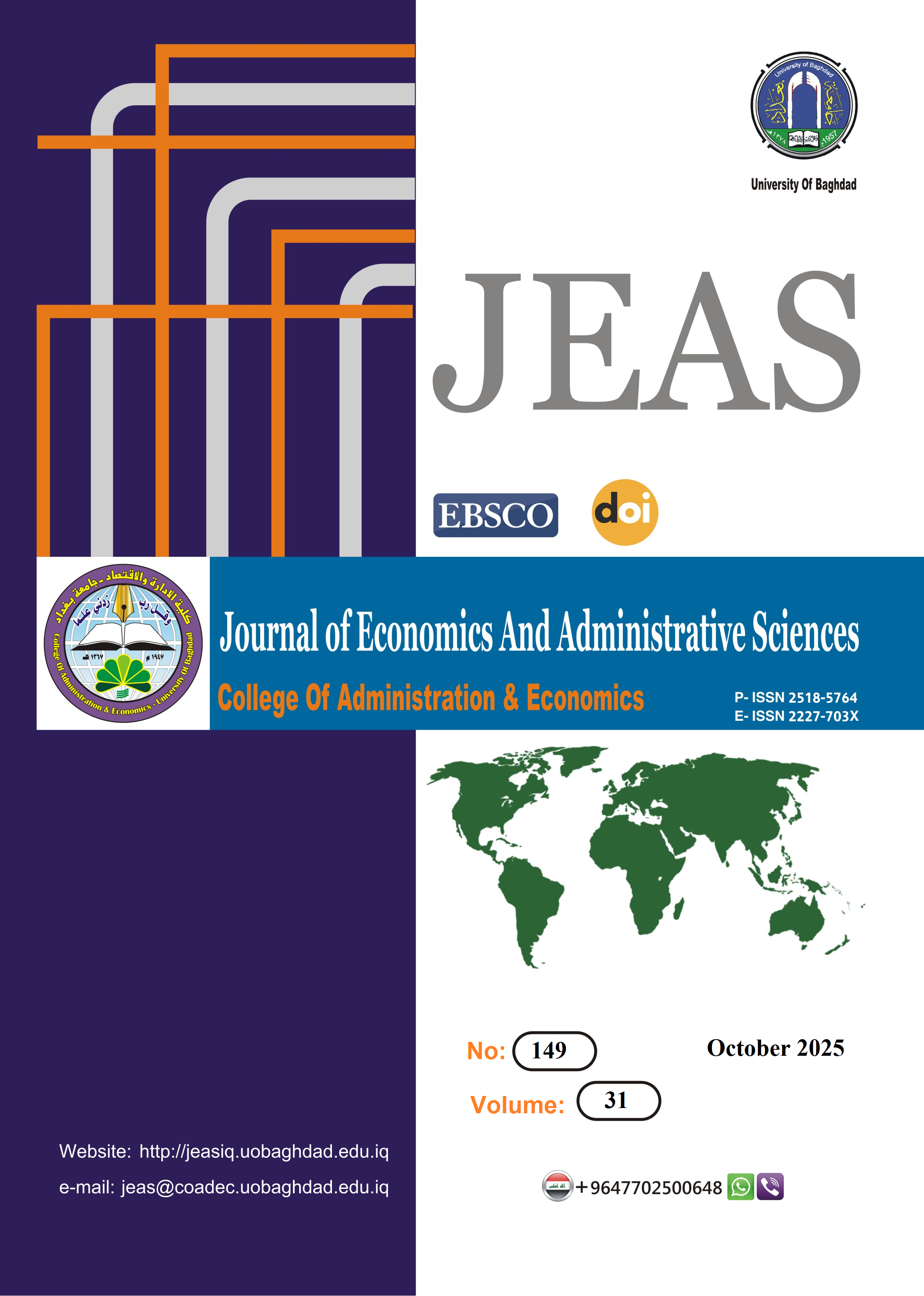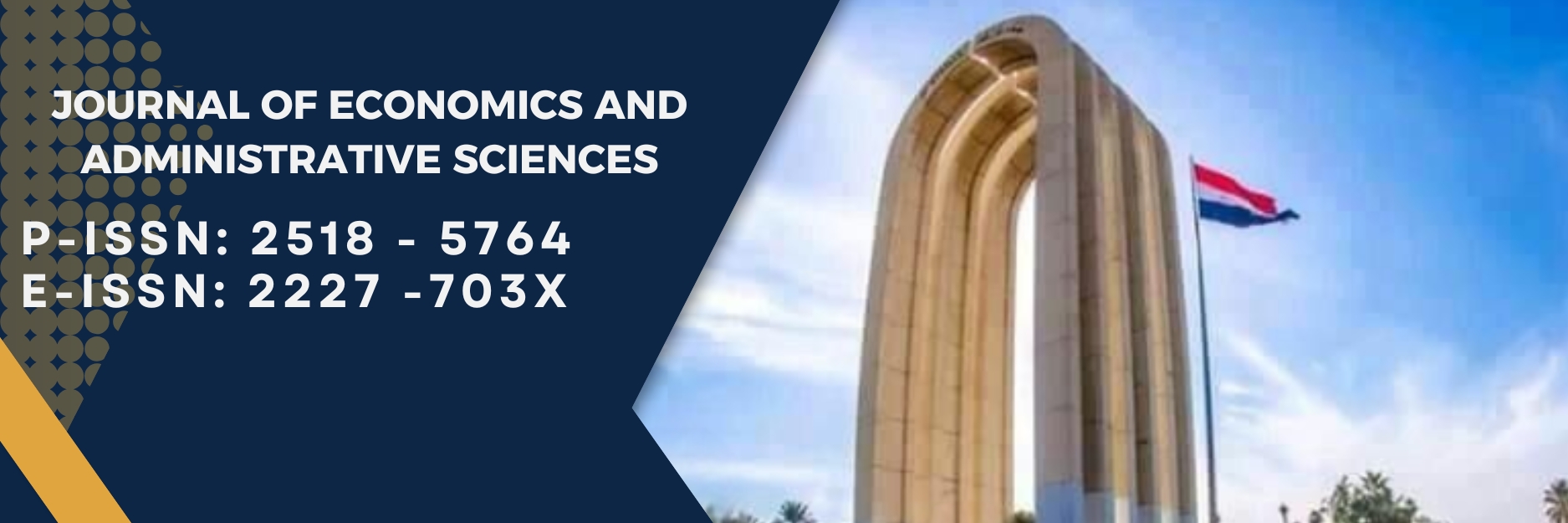Using some artificial intelligence algorithms to estimate the parametric regression function for spatially dependent data of water pollution of the Euphrates River
DOI:
https://doi.org/10.33095/8mjedd16Keywords:
Artificial intelligence, Genetic algorithm, Tabu search algorithm, Binary Firefly algorithm, spatially dependent data, Euphrates Riner water pollution.Abstract
These models account for the spatial effects resulting from the proximity of events. A compromise exists in the mathematical accuracy of model parameters when spatial correlations are present in the data of the phenomenon. Data reliant on spatial correlations are crucial in statistical modelling, especially in environmental science, economics, epidemiology, and various other disciplines.
This study employs and compares three artificial intelligence approaches—the genetic algorithm (GA), the TABU search algorithm (TSA), and the binary firefly algorithm (Binary FFA)—to determine which is the most efficient for estimating the parametric regression function for spatially dependent data.
The Mean Absolute Percentage Error numbers derived from the simulation demonstrated that the Binary FFA method yielded the most accurate estimations. This illustrates the superiority of the algorithm compared to conventional methods, as well as Genetic Algorithms (GA) and Tabu Search Algorithms (TSA), in environmental assessments (particularly, water pollution in the Euphrates River) and the estimation of regression models for geographically dependent data.
The regression parameter analysis for spatially dependent environmental data about Euphrates River pollution indicates that the temperature variablity exerted little influence on total dissolved salts. Conversely, the variables calcium (Ca), magnesium (Mg), and potassium (K) exhibited a significant and advantageous influence on total dissolved salts. In contrast, the variable sodium (Na) displayed a distinctly detrimental effect simultaneously.
Downloads
References
Abdel Hadia, A. T., & Redha, S. M. (2020). Estimate The Survival Function by Using the Genetic Algorithm. Journal of Economics and Administrative Sciences, 26(122), 440–454. https://doi.org/10.33095/jeas.v26i122.2018
Algamal, Z. (2019). Variable Selection in Count Data Regression Model based on Firefly Algorithm. Statistics, Optimization & Information Computing, 7(2). https://doi.org/10.19139/soic.v7i2.566
Al-Tamimi, S. A. S. (n.d.). Compared Study to Some of The Application Practical With (Data Panel) for Model Spatial Dynamic the Estimating of Methods. [Doctoral dissertation, Mustansiriyah university].
Anselin, L. (1988). Spatial Econometrics: Methods and Models (Vol. 4). Springer Netherlands. https://doi.org/10.1007/978-94-015-7799-1
Carr, J. (2014). An introduction to genetic algorithms. Computers & Mathematics with Applications, 32(6), 133. https://doi.org/10.1016/S0898-1221(96)90227-8
Chai, T., & Draxler, R. R. (2014). Root mean square error (RMSE) or mean absolute error (MAE)? – Arguments against avoiding RMSE in the literature. Geoscientific Model Development, 7(3), 1247–1250. https://doi.org/10.5194/gmd-7-1247-2014
Dawood, J. M. (2012). Foundations of spatial analysis. 59–80.
Dubin, R. A. (1988). Estimation of Regression Coefficients in the Presence of Spatially Autocorrelated Error Terms. The Review of Economics and Statistics, 70(3), 466. https://doi.org/10.2307/1926785
Duczmal, L., Cançado, A. L. F., Takahashi, R. H. C., & Bessegato, L. F. (2007). A genetic algorithm for irregularly shaped spatial scan statistics. Computational Statistics & Data Analysis, 52(1), 43–52. https://doi.org/10.1016/j.csda.2007.01.016
Eleas, A. K., & Aboudi, E. H. (2024). Expectation Parameters in the Poisson Mixture Regression Model for Latent Class by Applying Genetic Algorithm and Maximization Algorithm. Journal of Economics and Administrative Sciences, 30(140), 434–449. https://doi.org/10.33095/jeas.v26i122.2018
Ezugwu, A. E.-S., Agbaje, M. B., Aljojo, N., Els, R., Chiroma, H., & Elaziz, M. A. (2020). A Comparative Performance Study of Hybrid Firefly Algorithms for Automatic Data Clustering. IEEE Access, 8, 121089–121118. https://doi.org/10.1109/ACCESS.2020.3006173
Glover F, & Laguna M. (1998). Tabu search. Springer US.
Glover F, Laguna M, & Marti R. (2007). Principles of Tabu Search. Approximation Algorithms and Metaheuristics., 23(1), 1–12.
Hassanien, A. E., & Emary, E. (2018). Swarm Intelligence. CRC Press. https://doi.org/10.1201/9781315222455
He, Z., Shen, X., Zhou, Y., & Wang, Y. (2024). Application of K-means clustering based on artificial intelligence in gene statistics of biological information engineering. Proceedings of the 2024 4th International Conference on Bioinformatics and Intelligent Computing, 468–473. https://doi.org/10.1145/3665689.3665767
Hertz, A., Taillard, E., & De Werra, D. (1995). A Tutorial on Tabu Search.
Hoshino, T. (2018). Semiparametric Spatial Autoregressive Models with Endogenous Regressors: With an Application to Crime Data. Journal of Business & Economic Statistics, 36(1), 160–172. https://doi.org/10.1080/07350015.2016.1146145
Kelejian, H. H., & Prucha, I. R. (1998). A Generalized Spatial Two-Stage Least Squares Procedure for Estimating a Spatial Autoregressive Model with Autoregressive Disturbances. The Journal of Real Estate Finance and Economics, 17(1), 99–121. https://doi.org/10.1023/A:1007707430416
LeSage, J. P. (2015). “Theory and Practice of Spatial Econometrics.” Spatial Economic Analysis, 10(3), 400–400. https://doi.org/10.1080/17421772.2015.1062285
Martins-Filho, C., & Yao, F. (2009). Nonparametric regression estimation with general parametric error covariance. Journal of Multivariate Analysis, 100(3), 309–333. https://doi.org/10.1016/j.jmva.2008.04.013
Matazi, A. K., Gognet, E. E., & Kakaï, R. G. (2024). Digital soil mapping: a predictive performance assessment of spatial linear regression, Bayesian and ML-based models. Modeling Earth Systems and Environment, 10(1), 595–618. https://doi.org/10.1007/s40808-023-01788-1
Musa, O. E., & Ridha, S. M. (2023). Using the artificial TABU algorithm to estimate the semi-parametric regression function with measurement errors. 040037.
https://doi.org/10.1063/5.0126025
Ons Edin Musa, & Sabah Manfi Ridha. (2022). Semi-parametric regression function estimation for environmental pollution with measurement error using artificial flower pollination algorithm. International Journal of Nonlinear Analysis and Applications., 13(1), 1375–1389.
Piniganti L. (n.d.). A Survey of Tabu Search in Combinatorial Optimization. UNLV Theses, Dissertations, Professional Papers, and Capstones. 2132.
http://dx.doi.org/10.34917/5836151
Reeves, C. R. (2010). Genetic algorithms. In Handbook of metaheuristics (pp. 109-139). Springer, Boston, MA.
Safe, M., Carballido, J., Ponzoni, I., & Brignole, N. (2004). On Stopping Criteria for Genetic Algorithms (pp. 405–413). https://doi.org/10.1007/978-3-540-28645-5_41
Sainsbury-Dale, M., Zammit-Mangion, A., Richards, J., & Huser, R. (2025). Neural Bayes Estimators for Irregular Spatial Data Using Graph Neural Networks. Journal of Computational and Graphical Statistics, 1–16.
https://doi.org/10.1080/10618600.2024.2433671
Sivanandam SN, D. S. S. S. D. S. (2008). Introduction to Genetic Algorithms. Springer Berlin Heidelberg. https://doi.org/10.1007/978-3-540-73190-0
Yang, X. S. (2009). Firefly algorithms for multimodal optimization. In International symposium on stochastic algorithms (pp. 169-178). Berlin, Heidelberg: Springer.
https://doi.org/10.1007/978-3-642-04944-6_14
Yang XS. (2010). Nature-inspired metaheuristic algorithms. Luniver press.
Younis, A., Belabbes, F., Cotfas, P. A., & Cotfas, D. T. (2024). Utilizing the Honeybees Mating-Inspired Firefly Algorithm to Extract Parameters of the Wind Speed Weibull Model. Forecasting, 6(2), 357–377. https://doi.org/10.3390/forecast6020020
Published
Issue
Section
License
Copyright (c) 2025 Journal of Economics and Administrative Sciences

This work is licensed under a Creative Commons Attribution-NonCommercial-NoDerivatives 4.0 International License.
Articles submitted to the journal should not have been published before in their current or substantially similar form or be under consideration for publication with another journal. Please see JEAS originality guidelines for details. Use this in conjunction with the points below about references, before submission i.e. always attribute clearly using either indented text or quote marks as well as making use of the preferred Harvard style of formatting. Authors submitting articles for publication warrant that the work is not an infringement of any existing copyright and will indemnify the publisher against any breach of such warranty. For ease of dissemination and to ensure proper policing of use, papers and contributions become the legal copyright of the publisher unless otherwise agreed.
The editor may make use of Turtitin software for checking the originality of submissions received.


























